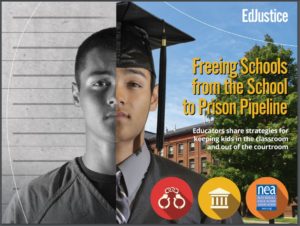In one photo is a broken chair. In another is a man with a battered face. The disturbing black-and-white images tell a story about a violent incident that took place decades ago in San Quentin State Prison, and are among thousands of photographs that Sacramento State professor Nigel Poor is documenting and interpreting for a history project illuminating the untold stories of those behind bars.
It all started four years ago. Poor, who taught history of photography classes at San Quentin through the Prison University Project, saw aerial photos of San Quentin on the desk of the prison’s public information officer. When she expressed interest in them, he handed her a banker’s box filled with negatives taken at the prison between 1935 and 1986, and said there were five more waiting.
The California Faculty Association member immediately knew she’d been handed a treasure trove of artifacts and decided to undertake the huge project of organizing, scanning and producing prints from thousands of negatives. She devotes hours to what she calls a labor of love, and sees no end in sight.
“These photos show that people can find meaning and be contributing citizens even if they are incarcerated.”

Educators can help keep kids in the classroom and out of the courtroom. Read about various strategies in NEA EdJustice’s special report at NEApipeline.
She encourages a group of inmates she works with to help interpret the photos and guide her understanding of what might have happened. Not all the photos are sad or violent; many are touching. In one photo, inmates are helping firefighters rescue a seal. Another, which has been titled “Mother’s Day,” shows an inmate having a tender moment with a female visitor, resting his head on her shoulder.
“These photos show that people can find meaning and be contributing citizens even if they are incarcerated,” says Poor. “They humanize inmates in a very real way — even though many of them have done terrible things and made terrible choices. I have found hope and inspiration can exist inside prison and that there are a lot of smart and talented people on the inside.”
The photographs are not her only prison project. She recently won a Jefferson Award for a podcast she creates with inmates called Ear Hustle — prison slang for eavesdropping — which details daily life inside prison. Topics include what the first day of prison is like, pets in prison, coping with HIV, and how birthdays are celebrated behind bars. The Jefferson Awards Foundation honors programs that are focused on community leadership.
The podcast, which launched last June, is so successful that it won an international contest to be broadcast nationwide on the Radiotopia online network.
“This award is for myself and the men (inmates) I work with, because we produce this podcast as colleagues and collaborators,” says Poor. “Our plan is to offer a real range of stories that are funny, poignant, uplifting and educational.”
Poor says her work at the prison has made her more compassionate as a person and increased her awareness of the need for prison reform. It has also made her more aware of victims’ rights, too.
“I have never been a victim of a violent crime,” she says. “Sometimes I feel torn. But one day many of these men will come out of prison. And I think everybody agrees that it is in everybody’s best interest if the angry and violent person who came into prison can be transformed into someone who is not angry and violent when he leaves. And hopefully, through my work, I can help with that.”
For more information on Poor’s projects, visit her website at nigelpoor.com. To hear podcasts, tune in to earhustlesq.com.
Reroute the School-to-Prison Pipeline
Policies and practices that favor incarceration over education do us all a grave injustice. Through a toolkit and multiple resources, Teaching Tolerance suggests five ways educators can reroute the school-to-prison pipeline by shifting the approach they take toward students, from a punitive one to a responsive one.
Shift 1: Adopt a social-emotional lens. Teach to the whole child.
Shift 2: Know your students and develop your cultural competency. Learn and affirm the social and cultural capital your students bring to the classroom.
Shift 3: Plan and deliver effective student-centered instruction. Teach with the purpose and urgency your students deserve.
Shift 4: Move the paradigm from punishment to development. Model, reinforce and praise positive, healthy behavior.
Shift 5: Resist the criminalization of school behavior. Keep kids in the classroom and police out.
Go to tolerance.org (search for “rerouting pipeline”) for more.
The Discussion 0 comments Post a Comment